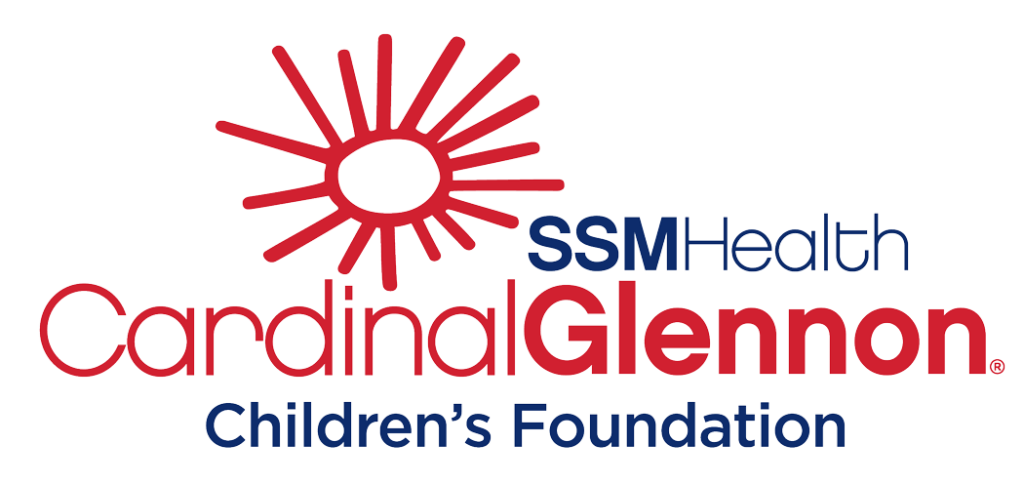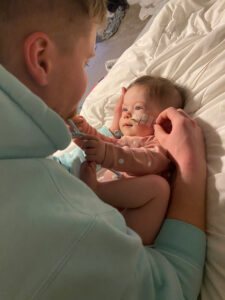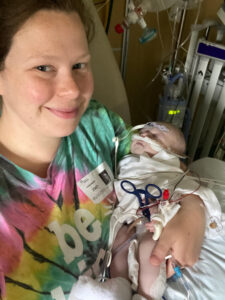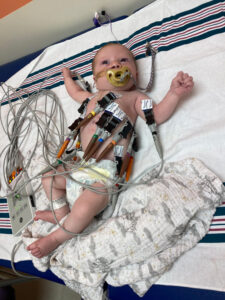Our Patients:
Elliot McDonald

Hailey McDonald of House Springs, MO recalls the day of her daughter, Elliot’s 20-week anatomy scan.
“I remember sitting in the lobby for over an hour after my scan,” said Hailey. “That’s never a good sign, especially when you know both your tech AND your OB each have over 30 years’ experience.”
Hailey’s OB brought Hailey and her husband, Caleb into a room to discuss the results of the ultrasound. Both experienced nurses, and parents to one older sibling (Robyn, age 2 years), the couple anxiously awaited explanation. Minutes later, Hailey and Caleb found themselves in a state of numbness. The doctor suspected their baby had hypoplastic left heart syndrome (HLHS) and suggested they make an appointment with the St. Louis Fetal Care Institute at SSM Health Cardinal Glennon at the earliest availability. Ten days later, Hailey and Caleb had that first appointment. It was the beginning of a lifetime relationship with their new home away from home.
Hypoplastic left heart syndrome (HLHS) is a rare congenital heart defect in which the left side of the heart is severely underdeveloped and incapable of supporting the systemic circulation. If left untreated, patients with HLHS die within the first weeks of life; therefore, the standard of care for all babies with HLHS is to have three surgeries done at three separate times. Referred to as “staged reconstruction” these surgeries collectively reconstruct the heart and circulatory system. While they don’t cure HLHS, they can help improve the patient’s stability.
At 21 weeks, Hailey and Caleb walked into SSM Health Cardinal Glennon for the first time. Their appointment at The St. Louis Fetal Care Institute was filled with multiple tests, conversations, and a roller coaster of emotions. Among countless things that Hailey admittedly can’t remember, there was a fetal echocardiogram and confirmation of the HLHS diagnosis. They met cardiothoracic surgeon, Dr. Corinne Tan, and cardiologist – Dr. Gloria Lehmann. They discussed the plan of care leading up TO delivery and the broad plan of care and surgical roadmap for after the baby was born. From that day forward, Hailey had, on average, 2-3 appointments per week between her visits to FCI for growth scans and fetal echocardiograms, her OB, the high-risk OB and other required tests. The plan was for Hailey to deliver at SSM Health St. Mary’s Hospital, with an immediate transport of the baby to SSM Health Cardinal Glennon.
“I went into labor at 38 weeks,” Hailey said. “I was in labor less than 12 hours, and we had no idea what kind of entry that Elliot would have into the world. The doctors and FCI staff prepared us as much as they could for what we could and should expect. We had a tour of the NICU, a tour of the PICU, a tour of the delivery room, and of course, LOTS of conversation. But nothing can really prepare you for your own unique experience. I was terrified of so much unknown,” Hailey said.
Elliot was born on April 30, 2023. It was an uncomplicated labor, uncomplicated delivery. Hailey got to hold her, have skin to skin time, kiss her and take photos with her. The SSM Health Cardinal Glennon Transport Team was on standby in the delivery room the whole time, and within less than 30 minutes of delivery, they had Elliot in the incubator and prepared for transport to the Neonatal Intensive Care Unit (NICU).
“I was so fortunate that I could be discharged the day after I delivered. Seeing Elliot on the NIC View camera was a gift the first night when I couldn’t leave, but I was anxious to join Caleb, who had followed Elliot to the hospital and navigated what would be our new territory. Except for that very first night, we both spent the night, every night with her after that,” Hailey said.
The surgeries done to repair HLHS are the Norwood procedure, the Glenn or Kawashima procedure, and the Fontan procedure. Each of these creates pathways to get the correct blood flow to the body and lungs. The Norwood procedure is the first surgery, usually performed within days of birth. It includes the placement of a shunt, which sends more blood to the lungs to pick up oxygen. After the Norwood procedure, oxygen-rich and oxygen-poor blood continue to mix within the heart. Once a baby has this treatment, the odds of survival can and should go up.
Elliot had her first surgery (the Norwood) 4 days after her birth. She immediately went to the Pediatric Intensive Care Unit with an anticipated minimal 4-6 weeks recovery. Multiple different factors determine whether that recovery time is shorter or longer. Fortunately, Elliot was extubated and got her breathing tube out successfully 1.5 weeks after surgery. Unfortunately, she was plagued with extensive feeding challenges, which is not necessarily uncommon for children with this diagnosis.
The compromised heart function in HLHS can lead to fatigue during feeding, making it hard for babies to coordinate sucking, swallowing, and breathing simultaneously. Since the Norwood procedure is done so soon after birth, some babies also have limited oral feeding before that surgery, impacting their ability to easily transition to bottle or breast feeding after surgery. Issues like gastroesophageal reflux (GERD), vocal cord dysfunction, and respiratory distress can further complicate feeding, also. Elliot was the poster child for ALL these issues and required nasogastric feedings with a tube to ensure adequate caloric intake.
“I exclusively breastfed my first daughter for an entire year,” said Hailey. “Elliot’s feeding issues were emotionally challenging to say the least. We tried all the bottles; all the techniques. I tried a dairy- free diet and we tried multiple different formulas. She choked and vomited with nearly every feeding, and she had a really tough time gaining weight. She just cried all the time, so we didn’t know if she was in pain or if she was hungry. Fortunately, since Caleb and I were both nurses, we were comfortable with the insertion and maintenance of the NG tube. We were able to be discharged at 6 weeks with an understanding that we’d be in frequent contact with her cardiology and nutrition team,” Hailey said.
Elliot was discharged home with a schedule of NG tube feedings and oxygen saturation monitoring. She had 8 tube feedings per day and a continuous pump feeding overnight. During Elliot’s recovery at the hospital, Hailey and Caleb agreed to enroll Elliot in SSM Health Cardinal Glennon’s NPC-QIC study group. The NPC-QIC (National Pediatric Cardiology-Quality Improvement Collaborative) is a central driving force for understanding the standards of present practice and setting the framework for collaborative and innovative progress in improving the quality and quantity of life for cardiac patients. SSM Health Cardinal Glennon is an NPC-QIC member and recruits families to enroll and use quality improvement methodology to actively learn how to decrease mortality and improve outcomes for infants with rare and complex congenital heart defects. “I had twice weekly check-ins over the phone with staff from the hospital,” Hailey said. “They sent me home with an infant scale and the most responsive, attentive dietician, EVER. When we were discharged, she was in the 5th percentile for weight. Over the next several months, we were in constant communication trying anything that might make a difference. We tried stopping breastmilk entirely. We tried thickening agents. We tried hypoallergenic formulas, supplements and introducing solid foods. Finally, by 6 or 7 months of age, she rose to the 17th percentile for weight and her vomiting had decreased to 2-3 times/day.
A Glenn procedure or Kawashima procedure is the second reconstructive surgery for HLHS, performed when the child is around four to eight months old. Elliot had her Kawashima procedure at 8 months of age, and while it was estimated she would have a 7–10-day hospital stay, she was discharged on day 4. Approximately 2 weeks after that surgery, her vomiting issues ceased. She started taking more foods by mouth, was able to get rid of her feeding tube, and slowly started gaining more weight.
“I continued to keep a journal and track her calories and hydration, making sure she had the right combination of macro and micronutrients to meet her needs. Prior to this second surgery, Elliot had a great need for regular therapies like physical therapy, occupational therapy, and speech therapy, which were provided at our home from First Steps. Within weeks of this second surgery, she graduated from all of them! She is completely on track with her physical milestones and is way ahead on her cognitive development. One of the biggest celebrations was seeing her enjoy birthday cake on her first birthday – a milestone that we didn’t know we’d be able to see,” said Hailey. “We graduated from Alexandra, our dietician, because she was doing so well by the time she made it to her first birthday. It was honestly bittersweet since she was one of the blessings amidst our chaos. She was so thorough, so patient, and reassuring at every turn. Both she and Dr. Lehmann were incredible about keeping in touch. I knew I could call either of them with any concerns, and at any time.”
The Fontan procedure is the third and final surgery, performed between 18 months and five years of age. “We are hoping she can make it to age 3 before she needs it,” said Hailey. “Her first year of life was the most stressful time of our lives. Even though she gets a little winded when she plays, it is such a gift to see her running around and doing everything an average toddler does.” Elliot is followed by multiple services including Cardiothoracic Surgery, Cardiology, Gastroenterology, Otolaryngology, Nephrology, Footprints and STARS. When asked if there was anything that could have made her journey easier, Hailey recalled the intense feelings of isolation and anxiety that are seemingly inevitable with the diagnosis and treatment. “I wish I had had a mentor – someone who had been through a similar journey as me.” Hailey now volunteers her time as a mentor for Caring Connections. – a program which offers guidance and support by pairing caregivers with compassionate mentors who have been through similar lived experiences.














